
Legendary Soviet camera lens Gelios 40-2 was developed in 1957 and for a long period of time has been one of the most popular camera lenses used for taking portrait photographs. A few years ago “Shvabe” Holdings restarted the production of the once popular model. The lens has been significantly redesigned and adapted for use with Nikon and Canon bayonet locking connectors.
Gelios 40 85 mm f/1.5 lens came into production at Krasnogorsk factory n. a. Zverev in 1957. The device was a high-aperture camera lens with one-layer blooming for cameras equipped with M42 connection thread.
In 1970 Gelios 40 was replaced with Gelios 40-2 modification. The featured novelties included black casing instead of metal plated, an optical filter with M77 connection thread (instead of M77 thread), amber color of blooming coating (instead of violet). Gelios 40-2 modification has been produced unchanged until the early 1990s.

In 2012 “Shvabe” Holdings restarted the Gelios 40-2 camera lens production at Krasnogorsk factory. In addition to the screw mounting type, the Nikon and Canon bayonet connector versions are available. The new models have been named Gelios 40-2С 85 мм f/1.5 and Gelios 40-2Н 85 мм f/1.5 respectively. In 2015 the lens was slightly redesigned to match the other devices in the product line of camera lenses from Krasnogorsk factory.
At the peak of digital cameras popularity, Gelios 40-2 manual camera lens has become even more sought-for. In the days of film cameras, every single frame literally had a great value and manual focusing of the lens didn’t do it more popular. When digital cameras came, an unlimited number of shots and became available. That fact, combined with a possibility of digital processing of the taken pictures, made Gelios 40-2 manual camera lens more and more attractive.
Compared with images taken with modern lenses, Gelios 40-2’s images have more volume and seem softer. It seems like Gelios 40-2 lens transforms 2D dimension into 3D – the center of the image looks more contrasting than the sides of the picture. That aesthetic quality of the blur produced in the out-of-focus parts of an image produced by a lens (Bokeh) is one of the main features of Gelios 40-2 lenses.
Manual focusing of the lens Gelios 40-2 lens doesn’t make it suitable for reportage photography, but it could be successfully used to take art pictures and portraits.
Gelios 40-2 lens has high-light intensity of 1.5/85 and could be used for taking pictures in low light conditions without increasing sensitivity especially when camera stabilization system is used. High-light intensity is also helpful while taking still-life and landscape pictures as well as photographing small objects.

